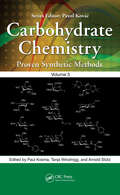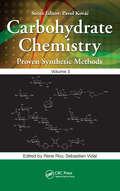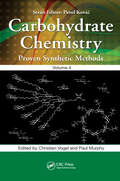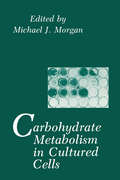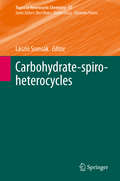- Table View
- List View
Carbohydrate-based Drug Discovery
by Chi-Huey WongTo exploit the full potential of this diverse compound class for the development of novel active substances, this handbook presents the latest knowledge on carbohydrate chemistry and biochemistry. While it is unique in covering the entire field, particular emphasis is placed on carbohydrates with pharmaceutical potential. Topics include the following: > Chemical Synthesis of Carbohydrates > Carbohydrate Biosynthesis and Metabolism > Carbohydrate Analysis > Cellular Functions of Carbohydrates > Development of Carbohydrate-based Drugs A premier resource for carbohydrate chemists and drug developers, this comprehensive two-volume work contains contributions by more than 50 of the world's leading carbohydrate chemists.
Carbohydrate-Based Interactions at the Molecular and the Cellular Level (Springer Theses)
by Kieran L. HudsonThis book offers a clearly written and highly accessible account of two different aspects of carbohydrate chemistry. Carbohydrates are an essential component of life and have many important biological functions, but the details of how carbohydrates interact with other biomolecules to mediate biological signalling remain unclear. Firstly, this thesis details innovative methods to mine protein structural data to uncover new features of carbohydrate-based interactions. It also explains these findings using physical chemistry, specifically CH–pi interactions associated with the properties of the interacting partners. Carbohydrates are also critical for tissue growth and development, yet are underexploited in the materials science that underpins much of regenerative medicine. As such, the second part of this thesis describes a diverse array of techniques ranging from synthetic chemistry and enzymatic synthesis to prepare a wide variety of carbohydrates, and materials chemistry to prepare glycosylated hydrogels, to cell biology to determine the effects on cellular development for tissue engineering applications.
Carbohydrate-Based Therapeutics
by Roberto Adamo Luigi LayCarbohydrate-Based Therapeutics Comprehensive resource summarizing opportunities and latest progress in design methodologies for carbohydrate-based therapeutics through a disease-oriented approach Carbohydrate-Based Therapeutics covers current progress and explores new frontiers in carbohydrate-based therapeutic applications, utilizing a unique approach by providing a detailed background of diseases coupled with subsequent carbohydrate-based therapies. The link between chemistry and design of novel carbohydrate-based medicines is highlighted and a broad overview of all the potential applications of carbohydrates is given. Emphasis is laid on concepts used for carbohydrate drug design, structure– activity relationship, and impact on health and diseases. The text also discusses newer topics like nanoparticles, material science, and tissue generation. Carbohydrate-Based Therapeutics includes information on: Antimicrobial carbohydrate-based therapies, covering antibacterial and antiviral vaccines, antifungal therapies, anti-influenza therapeutics, and antiadhesive carbohydrates and glycomimetics Anti-cancer carbohydrate-based therapies, covering cancer vaccines and immunotherapy, and carbohydrate tools in cancer biology Carbohydrate-based therapies in metabolic, neuronal, and immune disorders, covering carbohydrate-based therapeutics for lysosomal disorders and neurodegenerative diseases New frontiers in carbohydrate-based therapies, covering carbohydrates for tissue engineering, antiangiogenic and regenerative medicine Providing comprehensive coverage of foundational knowledge on the subject in a unique and highly accessible format while also exploring the state of the art in the field’s applications, Carbohydrate-Based Therapeutics is an essential resource for medicinal, pharmaceutical, and organic chemists, chemists in industry, biochemists, and biotechnologists.
Carbohydrate-Based Therapeutics
by Roberto Adamo Luigi LayCarbohydrate-Based Therapeutics Comprehensive resource summarizing opportunities and latest progress in design methodologies for carbohydrate-based therapeutics through a disease-oriented approach Carbohydrate-Based Therapeutics covers current progress and explores new frontiers in carbohydrate-based therapeutic applications, utilizing a unique approach by providing a detailed background of diseases coupled with subsequent carbohydrate-based therapies. The link between chemistry and design of novel carbohydrate-based medicines is highlighted and a broad overview of all the potential applications of carbohydrates is given. Emphasis is laid on concepts used for carbohydrate drug design, structure– activity relationship, and impact on health and diseases. The text also discusses newer topics like nanoparticles, material science, and tissue generation. Carbohydrate-Based Therapeutics includes information on: Antimicrobial carbohydrate-based therapies, covering antibacterial and antiviral vaccines, antifungal therapies, anti-influenza therapeutics, and antiadhesive carbohydrates and glycomimetics Anti-cancer carbohydrate-based therapies, covering cancer vaccines and immunotherapy, and carbohydrate tools in cancer biology Carbohydrate-based therapies in metabolic, neuronal, and immune disorders, covering carbohydrate-based therapeutics for lysosomal disorders and neurodegenerative diseases New frontiers in carbohydrate-based therapies, covering carbohydrates for tissue engineering, antiangiogenic and regenerative medicine Providing comprehensive coverage of foundational knowledge on the subject in a unique and highly accessible format while also exploring the state of the art in the field’s applications, Carbohydrate-Based Therapeutics is an essential resource for medicinal, pharmaceutical, and organic chemists, chemists in industry, biochemists, and biotechnologists.
Carbohydrate-Based Vaccines and Immunotherapies (Wiley Series in Drug Discovery and Development #8)
by Zhongwu Guo Geert-Jan BoonsThe fundamental science and the latest developments in carbohydrate-based vaccines The relatively new field of glycoimmunology has emerged from the marriage of glycobiology and immunology, in recognition of the important role carbohydrates play as antigenic determinants. Carbohydrate-Based Vaccines and Immunotherapies comprehensively reviews the state of this exciting field, offering a single source for both the fundamental science and the latest developments. With contributions by leading experts, this resource covers the design, synthesis, evaluation, and applications of various carbohydrate-based vaccines, including polysaccharides, neoglycoproteins, and neoglycolipids. The text approaches vaccine design from a chemical and molecular focus, staying in line with current advances. Key topics covered by Carbohydrate-Based Vaccines and Immunotherapies include: Recent developments towards clinically useful vaccines against bacteria, viruses, parasites, and fungi Using adjuvants to improve immunogenicity and/or immunological properties of vaccines Choosing and designing proper adjuvants for specific targets Abnormal carbohydrates expressed by tumors Carbohydrate-based therapeutic cancer vaccines or cancer immunotherapy Clinical trials results for synthetic cancer vaccines Glycoengineering of cell surface carborhydrates and its anticancer applications Using cell surface carbohydrates for disease diagnosis A single, convenient source of state-of-the-art information from leading authorities in the field, Carbohydrate-Based Vaccines and Immunotherapies is an essential reference for organic chemists and biochemists, academic researchers, and other students and professionals involved in vaccine design.
Carbohydrate Biotechnology Protocols (Methods in Biotechnology #10)
by Christopher BuckeWe are in a phase of the evolution of biotechnology in which the true and potential commercial importance of carbohydrates is becoming appre- ated more fully. Progress in providing hard facts to establish the commercial value ofpolysaccharides and oligosaccharides is limited, as always, by lack of funding and by a relative shortage of skilled practitioners in the production and analysis of those materials. Carbohydrate science has a reputation, not unmerited, for technical difficulty owing to the structural similarity of the many monosaccharide monomers and the potential, and real, complexity of oligosaccharides and polysaccharides, particularly heterosaccharides conta- ing many different monomers. Modem analytical and synthetic methods, in many cases using enzyme technology, are beginning to allow this complexity to be unraveled. Carbohydrate Biotechnology Protocols is aimed at those newcomers who have an interest in the production and use of carbohydrate materials, but have shied away from involvement for lack of detailed descriptions of appropriate methods, including the type of practical hints that may be provided by those skilled in those methods, but that are rarely described in research papers. The majority of the contributions to this book conform to the established format of the Methods in Biotechnology series. They begin with the theoretical and c- mercial background to the method or group of methods, provide a list of the reagents and equipment required for the procedure, then give a detailed st- by-step description of how to carry out the protocol.
Carbohydrate Chemistry: Proven Synthetic Methods, Volume 5 (Carbohydrate Chemistry: Proven Synthetic Methods #1)
by Paul Kosma Tanja M. Wrodnigg Arnold StützVolumes in the Proven Synthetic Methods Series address the concerns many chemists have regarding irreproducibility of synthetic protocols, lack of identification and characterization data for new compounds, and inflated yields reported in chemical communications—trends that have recently become a serious problem. Exploring carbohydrate chemistry from both the academic and industrial points of view, this unique resource brings together useful information into one convenient reference. The series is unique among other synthetic literature in the carbohydrate field in that, to ensure reproducibility, an independent checker has verified the experimental parts involved by repeating the protocols or using the methods. Featuring contributions from world-renowned experts and overseen by a highly respected series editor, this latest volume compiles reliable protocols for the preparation of intermediates for carbohydrate synthesis or other uses in the glycosciences. Key Features: Explains reliable and tested protocols for the preparation of intermediates for carbohydrate synthesis Offers a unique resource in glycosciences, compiling useful information in one reference Presents protocols that are of wide use to a broad range of readers in the carbohydrate field and the life sciences, including undergraduates taking carbohydrate workshops Explores synthetic carbohydrate chemistry from both the academic and industrial points of view Guarantees the reader a good, clean, reproducible experiment
Carbohydrate Chemistry: Proven Synthetic Methods, Volume 5 (Carbohydrate Chemistry: Proven Synthetic Methods #1)
by Paul Kosma Tanja M. Wrodnigg Arnold StützVolumes in the Proven Synthetic Methods Series address the concerns many chemists have regarding irreproducibility of synthetic protocols, lack of identification and characterization data for new compounds, and inflated yields reported in chemical communications—trends that have recently become a serious problem. Exploring carbohydrate chemistry from both the academic and industrial points of view, this unique resource brings together useful information into one convenient reference. The series is unique among other synthetic literature in the carbohydrate field in that, to ensure reproducibility, an independent checker has verified the experimental parts involved by repeating the protocols or using the methods. Featuring contributions from world-renowned experts and overseen by a highly respected series editor, this latest volume compiles reliable protocols for the preparation of intermediates for carbohydrate synthesis or other uses in the glycosciences. Key Features: Explains reliable and tested protocols for the preparation of intermediates for carbohydrate synthesis Offers a unique resource in glycosciences, compiling useful information in one reference Presents protocols that are of wide use to a broad range of readers in the carbohydrate field and the life sciences, including undergraduates taking carbohydrate workshops Explores synthetic carbohydrate chemistry from both the academic and industrial points of view Guarantees the reader a good, clean, reproducible experiment
Carbohydrate Chemistry: Proven Synthetic Methods, Volume 3
by René Roy Sébastien VidalVolumes in the Proven Synthetic Methods Series address the concerns many chemists have regarding irreproducibility of synthetic protocols, lack of characterization data for new compounds, and inflated yields reported in chemical communications-trends that have recently become a serious problem.Featuring contributions from world-renowned experts and
Carbohydrate Chemistry: Proven Synthetic Methods, Volume 3
by René Roy Sébastien VidalVolumes in the Proven Synthetic Methods Series address the concerns many chemists have regarding irreproducibility of synthetic protocols, lack of characterization data for new compounds, and inflated yields reported in chemical communications-trends that have recently become a serious problem.Featuring contributions from world-renowned experts and
Carbohydrate Chemistry: Proven Synthetic Methods, Volume 4 (Carbohydrate Chemistry: Proven Synthetic Methods)
by Christian Vogel Paul MurphyVolumes in the Proven Synthetic Methods Series address the concerns many chemists have regarding irreproducibility of synthetic protocols, lack of identification and characterization data for new compounds, and inflated yields reported in chemical communications—trends that have recently become a serious problem.Featuring contributions from world-renowned experts and overseen by a highly respected series editor, Carbohydrate Chemistry: Proven Synthetic Methods, Volume 4 compiles reliable synthetic methods and protocols for the preparation of intermediates for carbohydrate synthesis or other uses in the glycosciences. Exploring carbohydrate chemistry from both the academic and industrial points of view, this unique resource brings together useful information into one convenient reference. The series is unique among other synthetic literature in the carbohydrate field in that, to ensure reproducibility, an independent checker has verified the experimental parts involved by repeating the protocols or using the methods.The book includes new or more detailed versions of previously published protocols as well as those published in not readily available journals. The essential characteristics of the protocols presented are reliability, updated characterization data for newly synthesized substances and the expectation of wide utility in the carbohydrate field. The protocols presented will be of wide use to a broad range of readers in the carbohydrate field and the life sciences, including undergraduates taking carbohydrate workshops.
Carbohydrate Chemistry: Proven Synthetic Methods, Volume 4 (Carbohydrate Chemistry: Proven Synthetic Methods)
by Christian Vogel Paul V. MurphyVolumes in the Proven Synthetic Methods Series address the concerns many chemists have regarding irreproducibility of synthetic protocols, lack of identification and characterization data for new compounds, and inflated yields reported in chemical communications—trends that have recently become a serious problem.Featuring contributions from world-renowned experts and overseen by a highly respected series editor, Carbohydrate Chemistry: Proven Synthetic Methods, Volume 4 compiles reliable synthetic methods and protocols for the preparation of intermediates for carbohydrate synthesis or other uses in the glycosciences. Exploring carbohydrate chemistry from both the academic and industrial points of view, this unique resource brings together useful information into one convenient reference. The series is unique among other synthetic literature in the carbohydrate field in that, to ensure reproducibility, an independent checker has verified the experimental parts involved by repeating the protocols or using the methods.The book includes new or more detailed versions of previously published protocols as well as those published in not readily available journals. The essential characteristics of the protocols presented are reliability, updated characterization data for newly synthesized substances and the expectation of wide utility in the carbohydrate field. The protocols presented will be of wide use to a broad range of readers in the carbohydrate field and the life sciences, including undergraduates taking carbohydrate workshops.
Carbohydrate Chemistry in the Total Synthesis of Naturally Occurring Glycosides
by Biao Yu Xiaoyu YangCarbohydrate Chemistry in the Total Synthesis of Naturally Occurring Glycosides Revolutionize your manufacturing processes and more with this groundbreaking introduction Carbohydrates and complex glycosides are important classes of molecules. The ubiquitous glycosides are extremely diverse in structure and functions, and many of them are of pharmacological significance. Purification of a homogeneous glycoside from the nature sources, especially in an appreciable amount, is always difficult. Chemical synthesis provides a feasible access to the homogenous glycosides and their congeners. Carbohydrate Chemistry in the Total Synthesis of Naturally Occurring Glycosides presents about 10 families of naturally occurring glycoside natural products, including about 150 molecules that organic chemists have devoted a lot of effort toward their synthesis. In each example, the background of each natural glycoside, including its natural resources, its isolation process and its bioactivities have been described; the total synthesis of the natural glycoside is presented with special emphasis on the glycosylation reaction, the strategy on saccharides assembly, the protecting group manipulation, and the method for the synthesis of the rare saccharide units. Readers can clearly see the progress of total synthesis of naturally occurring glycosides, from early to current arts, from simple to complex molecules, and from tedious strategy to highly efficient and economical methodologies in this book. It will highly benefit the further developments in the total synthesis of naturally occurring glycosides and synthetic carbohydrate chemistry. Carbohydrate Chemistry in the Total Synthesis of Naturally Occurring Glycosides is ideal for Organic Chemists, Biochemists, Pharmaceutical and Medicinal Chemists, Natural Products Chemists, and Pharmaceutical Industry
Carbohydrate Chemistry in the Total Synthesis of Naturally Occurring Glycosides
by Biao Yu Xiaoyu YangCarbohydrate Chemistry in the Total Synthesis of Naturally Occurring Glycosides Revolutionize your manufacturing processes and more with this groundbreaking introduction Carbohydrates and complex glycosides are important classes of molecules. The ubiquitous glycosides are extremely diverse in structure and functions, and many of them are of pharmacological significance. Purification of a homogeneous glycoside from the nature sources, especially in an appreciable amount, is always difficult. Chemical synthesis provides a feasible access to the homogenous glycosides and their congeners. Carbohydrate Chemistry in the Total Synthesis of Naturally Occurring Glycosides presents about 10 families of naturally occurring glycoside natural products, including about 150 molecules that organic chemists have devoted a lot of effort toward their synthesis. In each example, the background of each natural glycoside, including its natural resources, its isolation process and its bioactivities have been described; the total synthesis of the natural glycoside is presented with special emphasis on the glycosylation reaction, the strategy on saccharides assembly, the protecting group manipulation, and the method for the synthesis of the rare saccharide units. Readers can clearly see the progress of total synthesis of naturally occurring glycosides, from early to current arts, from simple to complex molecules, and from tedious strategy to highly efficient and economical methodologies in this book. It will highly benefit the further developments in the total synthesis of naturally occurring glycosides and synthetic carbohydrate chemistry. Carbohydrate Chemistry in the Total Synthesis of Naturally Occurring Glycosides is ideal for Organic Chemists, Biochemists, Pharmaceutical and Medicinal Chemists, Natural Products Chemists, and Pharmaceutical Industry
Carbohydrate Enzyme (tactile)
by Sheffield Vi ServiceThis is a labelled diagram showing a molecule of carbohydrate being broken down by an enzyme.
Carbohydrate Expression in the Intestinal Mucosa (Advances in Anatomy, Embryology and Cell Biology #160)
by R. Sharma U. SchumacherCarbohydrate Metabolism in Cultured Cells
by M. J. MorganIt is perhaps obvious to any student of Biology that the discovery of chemical processes in whole organisms has usually preceded the elucidation of the compo nent steps. However, it is perhaps less obvious that the unravelling of the se quences in which those chemical steps occur in living matter, of the precise mechanisms involved, and of the manner in which they are regulated, would have been achieved neither by the study of intact plants and animals nor even of extracts derived from them. Our ability to understand the nature and regulation of metabolism rests on two main premises: the postulate that life processes can indeed be validly investigated with individual cells and cell-free extracts, and the thesis that there is an essential "unity in biochemistry" (as Kluyver put it, 60 years ago) that enables events in one organism to be legitimately studied in another. Of particular utility in this latter respect has been the use of cultures of single-celled organisms, growing in defined media-especially prokaryotes, such as Escherichia coli, and eukaryotes, such as Neurospora and Sac charomyces sp. , to which both biochemical and genetical techniques could be applied. It was, of course, Pasteur's observations of bacterial fermentations that first overthrew the belief that oxygen was essential for all energy-yielding pro cesses: his recognition that "La fermentation . . . . . c' est La vie sans air" laid the foundations of our knowledge of glycolysis.
Carbohydrate Microarrays: Methods and Protocols (Methods in Molecular Biology #808)
by Yann ChevolotCarbohydrate microarrays emerged as a key technology for the deciphering of the glycospace by providing a multiplex technology where tens to hundreds of carbohydrates/protein interactions can be probed in parallel. Carbohydrate Microarrays: Methods and Protocols aims to give the reader the theoretical and experimental clues necessary for the fabrication and implementation of carbohydrate microarrays. This requires three essential steps: 1) to obtain the carbohydrate probes (monosacharides, oligosacchrides, polysacchairdes, glycoconjugates or glycoclusters), 2) to immobilize these probes, and 3) to implement the protocols for biological/biochemical interaction with the desired target. This volume gives an overview of carbohydrate microarray and carbohydrate chemistry and illustrates different detection techniques and their applications. Written in the successful Methods in Molecular Biology™ series format, chapters include introductions to their respective topics, lists of the necessary materials and reagents, step-by-step, readily reproducible protocols, and notes on troubleshooting and avoiding known pitfalls. Authoritative and easily accessible, Carbohydrate Microarrays: Methods and Protocols compiles a catalogue of protocols on carbohydrate microarrays to span the needs of researchers around the globe.
Carbohydrate Nanotechnology
by Keith J. StineIntroducing the emerging field carbohydrate nanostructures, this book will be a unique resource for interested researchers to learn a range of methods of applying the field to their own work. Greater access, as well as greater collaboration, to this new interdisciplinary field is intended for both synthetic carbohydrate chemists and researchers in nanoscience related fields. It covers: the main types of nanostructures presently under investigation for modification by carbohydrates, including nanoparticles, nanorods, magnetic particles, dendrimers, nanoporous, and surface confined structures overview and introduction to the field of carbohydrate nanotechnology, and especially its applications to its biological systems Provides a unique resource for researchers to learn about the techniques used to characterize the physical and biological properties of carbohydrate-modified nanostructures
Carbohydrate Nanotechnology
by Keith J. StineIntroducing the emerging field carbohydrate nanostructures, this book will be a unique resource for interested researchers to learn a range of methods of applying the field to their own work. Greater access, as well as greater collaboration, to this new interdisciplinary field is intended for both synthetic carbohydrate chemists and researchers in nanoscience related fields. It covers: the main types of nanostructures presently under investigation for modification by carbohydrates, including nanoparticles, nanorods, magnetic particles, dendrimers, nanoporous, and surface confined structures overview and introduction to the field of carbohydrate nanotechnology, and especially its applications to its biological systems Provides a unique resource for researchers to learn about the techniques used to characterize the physical and biological properties of carbohydrate-modified nanostructures
Carbohydrate-Protein Interaction (Current Topics in Microbiology and Immunology #139)
by Adrienne E. Clarke Ian A. WilsonCarbohydrate as the primary product of photosynthesis has a vital role in the maintenance of life on this planet. Until relatively recently, interest in complex carbohydrates focussed on their structural role in the extracellular matrix/ cell wall of animal, plant, and microbial cells and on their role as energy sources (e.g., starch and glycogen) and struc tural components (e.g., cellulose) in natural products. There was, however, indirect evidence that carbohydrates could play an informational role; this evidence was from the find ing last century that plant lectins caused specific agglutina tion of certain animal cells and, more recently, that the agglutination was mediated by interactions between the plant lectin and cell surface carbohydrates. It is now clear that endogenous carbohydrate binding proteins are important in cell-cell recognition phenomena in animal systems. Recently, impressive evidence has been presented that complex oligosaccharides, derived from cell walls, are also important in plant recognition events, for example in signalling the defence mechanisms of a plant to respond to attack by insects and microbial pathogens.
Carbohydrate-Protein Interactions: Methods and Protocols (Methods in Molecular Biology #2657)
by D. Wade Abbott Wesley F. ZandbergThis second edition provides new and updated tools for studying protein-carbohydrate interactions ranging from traditional biochemical methods to state-of-the-art techniques. This book focuses on four different research themes detailing methods for screening and quantifying CAZyme activity, investigating the interactions between proteins, carbohydrate ligands, methods for the visualization of carbohydrates, protein-carbohydrate complexes, structural and “omic” approaches for studying systems of CAZymes. Written in the format of the highly successful Methods in Molecular Biology series, each chapter includes an introduction to the topic, lists necessary materials and methods, includes tips on troubleshooting and known pitfalls, and step-by-step, readily reproducible protocols. Authoritative and cutting-edge, Carbohydrate- Protein Interactions: Methods and Protocols, Second Edition aims to be comprehensive guide for researchers in the field.
Carbohydrate Recognition in Cellular Function (Novartis Foundation Symposia #145)
by Gregory R. Bock Sara HarnettContributors to this volume explore the role of carbohydrates in communication between cells of multicellular organisms. Topics covered include the thermodynamics and spatial restrictions of oligosaccharide-protein interactions, the role of carbohydrates in recognition and as components of cell adhesion molecules, and abnormal glycosylation in several disease states.
Carbohydrate-spiro-heterocycles (Topics in Heterocyclic Chemistry #57)
by László SomsákThis volume is devoted to compounds in which the spiro centre is part of a pyranoid or furanoid or an iminosugar ring. The chapters contributed deal with methodological peculiarities of syntheses of natural and artificial sugar derived spirocycles as well as their biological applications and other utilities including marketed drugs. Carbohydrates are ubiquitous molecules in nature and participate in a vast number of biological interactions. Especially their conjugates with practically all kinds of primary and secondary metabolic small molecules (and also biomacromolecules) representing valuable tools for glycobiology research and also lead compounds for drug discovery. While monosaccharides per se appear as heterocycles, their natural conjugates frequently exhibit spiro(hetero)cyclic derivatives, in many cases of high therapeutical relevance. As a consequence, the field of carbohydrate-spiro-heterocycles attracts intense interest from both chemical and biomedical aspects therefore this volume will be of interest for synthetic and medicinal chemists and (glyco)biologists, as well as researchers involved in various biomedical fields.
Carbohydrates: Tools for Stereoselective Synthesis
by Mike Martin Kwabena BoysenClosing a gap in the literature, this comprehensive book presents the utility of carbohydrate derivatives as chiral auxiliaries, reagents, complex ligands and organocatalysts, together with details of their preparation, as well as their successful application in stereoselective synthesis. Divided into four parts: * Carbohydrate Auxiliaries * Carbohydrate Reagents * Carbohydrate Ligands * Carbohydrate Organocatalysts It is an indispensable source for every organic chemist.





